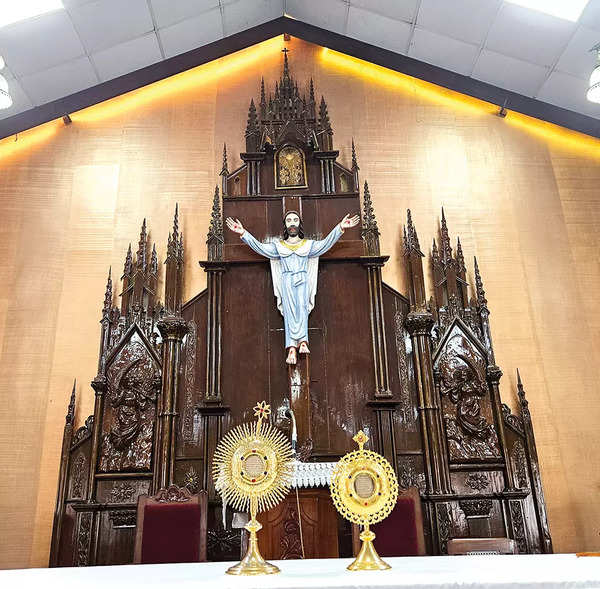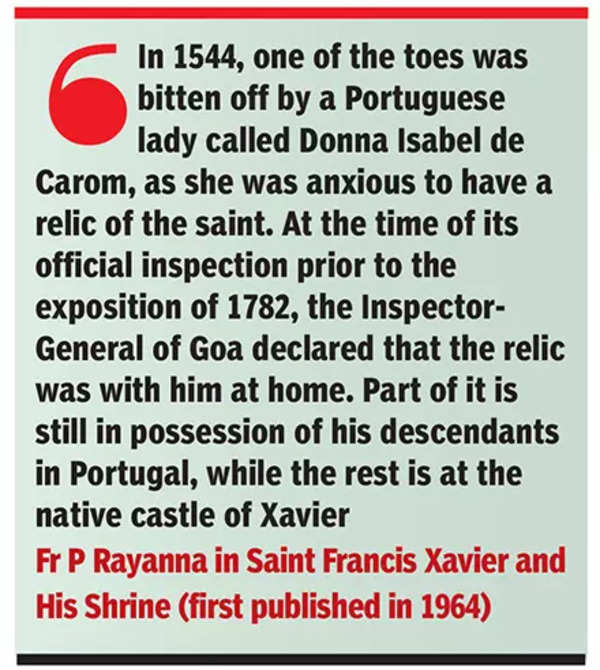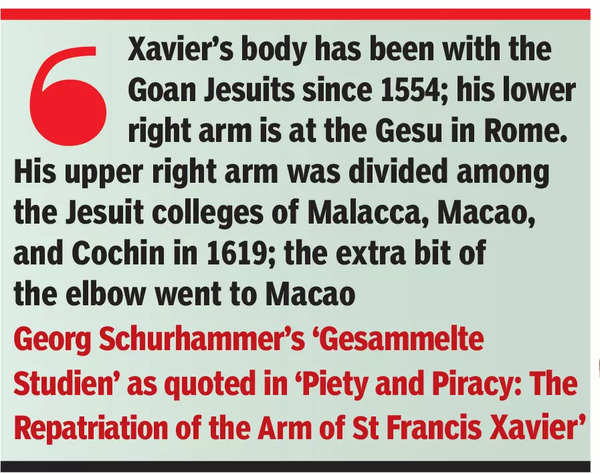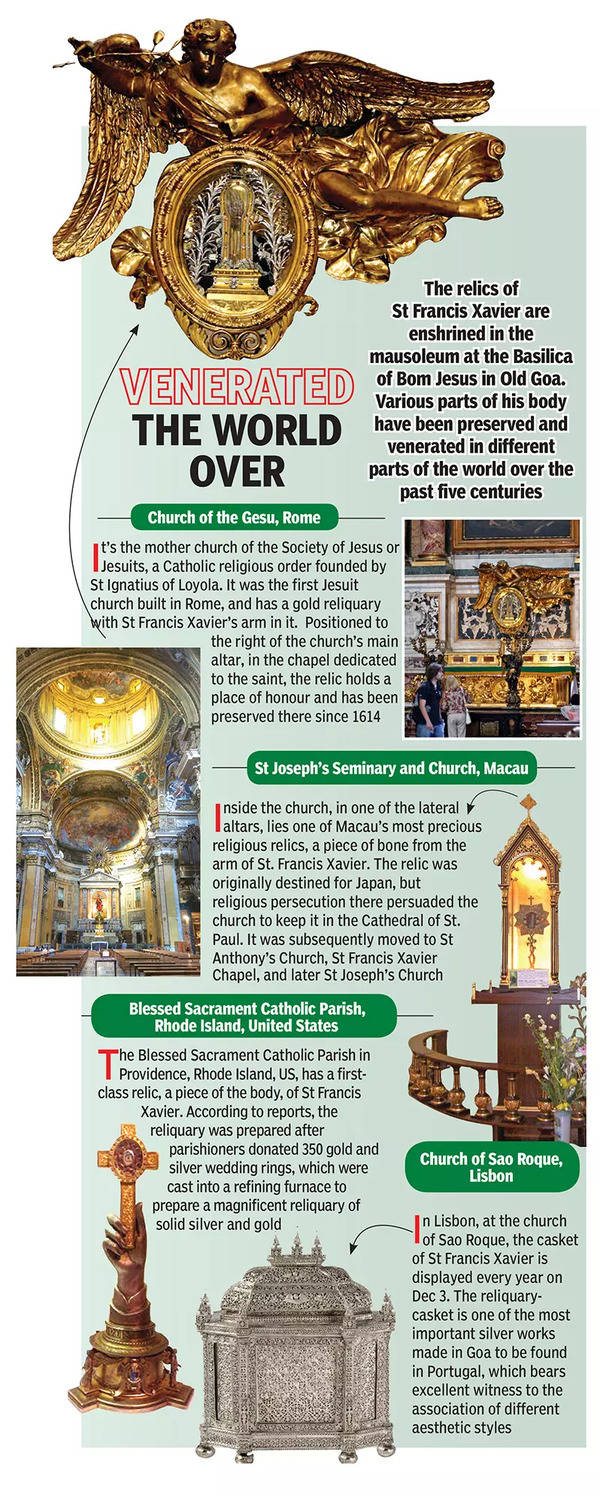
At Basilica of Bom Jesus in Old Goa is not the only place relics of St. Francis Xavier can be found. In selected churches, chapels and even in private homes, holy relics are skins, bones, nails, pieces of cloth and wooden relics from the case where the body of the saint was placed for many years. adored

In his office at the Church of the Holy Spirit in Margao, Fr Antonio Amandio Valadares opened a case that had been carefully guarded for a long time.
It contains relics of St Francis Xavier, and is only available for public veneration during the nine-day novena in Nov-Dec. For the rest of the year, the reliquary remains under lock and key.
“The relics are kept inside a strong room (in the church), with two separate locks,” Fr Valadares told TOI. Keys for two keys with different people.
The church is among the very few places outside the Basilica of Bom Jesus, Old Goa, which has a first class relic from Xavier. There is no documentation available with the Basilica or the Archdiocese of Goa regarding the relic outside Old Goa, but a 1950 note in Latin from the archbishop confirms its authenticity.
Translated from Latin and dated December 12, 1950, the inscription reads: “It contains a small leather relic of the body of St. Francis Xavier, kept in the Basilica of Bom Jesus.” The note bears the signature ‘Jose, Patriarch of Indies’.

A 500-year-old robe in St Xavier’s Church, Pune, is believed to have been worn by the saint himself.
Ever since the incorruptible body of Xavier was brought to Goa on the night of March 14, 1554, there has been a clamor for the holy relics. “Everyone wants to have relics that are supposed to be a link between humans and the supernatural world, so that some benefits will accrue to those who have these things. So, some people took body pieces or robes from the saint. Those who own the body also have the freedom to distribute relics as gifts,” writes IP Newman Fernandes in his book, St Francis Xavier & Old Goa.
As documented in ‘Pilgrimage to the tomb of Goencho Saib or St Francis Xavier’, “in the early years, pieces of St Francis Xavier’s skin and robe would be given as gifts to important political and ecclesiastical officials”.
However, the relics scattered across Goa in churches and chapels appear to be more recent. The crucifixion in Margao dates back to 1950, and the Church of St Francis Xavier in Bhatpal, Canacona, has a small skeleton of the saint, kept inside the reliquary monstrance.
“Before, people used to say it was the nail of a saint, but it says ‘ossibus’, which means bone (in Latin),” said parish priest Fr Fredy Lobo. “Not only Catholics, many Hindus come here to pay their respects. It is the faith of the people that draws them to the saint.”

SFX Church, Borim, has a relic in the form of a small cloth
No record is available as to when the relic was placed in Bhatpal. The church was originally a chapel, built on August 30, 1936. It functions under the jurisdiction of the parish of Canacona, and in 1968, the Chapel of St. Francis Xavier was removed from the parish of Canacona and appointed as an independent parish.
Even in the SFX chapel in Portais, Panaji, which has another first-class relic identified in Latin as ‘ex pelle S. Franc Xav’ or ‘from the skin of St Francis Xavier’, there is no documentation to show that the chapel dates back. has left.

“These relics are special and bring us closer to the saint,” said chapel committee member Olave Dias. “It has been here since the chapel was built. We have another chapel nearby and this one is newer.
The altar in the chapel was carved in Feb 1941, while the old chapel was built in 1880.
“The Church of the Holy Spirit in Margao, Bhatpal in Canacona, and Portais, these are the three places in Goa, at least as far as we know, where the relics of St Francis Xavier are kept,” said Fr Henry Falcao, organizer of the Exposition Committee. of the Archdiocese.
What is not commonly known is the existence of relics in Chandor. The 17th-century Braganza house has antique treasures collected from around the world, including gifts from the King of Portugal. But what remains a treasure is Xavier’s relic in the form of a nail, carefully kept in a private chapel for over two hundred years.

According to the owner, the relics were brought by the Jesuit priest Antonio Pereira, the last of the five priests in the family, between 1790 and 1810.
Another popular place where holy relics are venerated is in the Church of St. Francis Xavier, Borim. It is kept in a monstrance with a note from Fr A Le Tellier. It read: “A small piece of cloth that was placed on the head, hands and feet of St. Francis Xavier, when the body was moved to a new silver and crystal casket in February 1955.”
Chapel of St. Francis Xavier, Monte, Benaulim, has a “small cloth”, while last year, “a wooden relic from the case where the holy body was placed for several years” was installed in the Mae de Deus. chapel, Gaunsa-Vaddo, Siolim.





